Welcoming a new puppy into your life is an exhilarating journey filled with joy, laughter, and endless cuddles. As you start this adventure, it’s vital to establish a strong foundation for a well-behaved and obedient pet. Studies show that 85% of dogs benefit from physical touch for bonding and relaxation. Also, 93% of dog owners believe that adventures with their pets strengthen their bond. This highlights the importance of puppy obedience training in fostering a happy and harmonious relationship.
Imagine the pride you’ll feel when your puppy responds eagerly to your commands, showcasing their loyalty and intelligence. Picture the joy on your face as you watch your furry friend confidently navigate the world. Knowing you’ve equipped them with essential commands to teach a puppy is a source of pride. With 83% of dogs feeling valued and appreciated when learning new tricks, and 71% of owners prioritizing positive reinforcement, you have the power to shape your puppy into a well-mannered and confident companion.
In this article, we’ll explore the top 10 essential puppy training commands every dog should know. From basic obedience to important safety commands, you’ll discover effective puppy training tips. These tips will strengthen your bond and create a lifetime of cherished memories. Get ready to embark on a transformative journey with your puppy, unlocking their full potential and building a foundation of trust, respect, and unwavering love.
Why Training Your Puppy is Essential!
Welcoming a new puppy into your home is a thrilling and rewarding experience. Yet, it’s vital to grasp that training your furry companion is not merely a luxury but a necessity. A well-trained dog brings immense joy to your life, offering numerous benefits.
Investing time and effort in training your puppy establishes a strong, healthy bond. A well-trained dog is more obedient, responsive, and in tune with your needs. This enhances daily life, making it more manageable and enjoyable for both you and your pet.
Benefits of a Well-Trained Dog
A well-trained dog is inherently safer. They are less prone to destructive behaviors, such as chewing on furniture or getting into trash. They also exhibit better manners, making them more pleasant company. Key advantages of having a well-trained dog include:
- Improved safety for both the dog and those around them
- Reduced likelihood of developing behavioral issues
- Enhanced adaptability to different situations and environments
- Stronger bond and better communication between dog and owner
Importance of Starting Early
Starting puppy training early is crucial. Puppies are most receptive to learning between 8 and 16 weeks of age. During this period, they absorb information like sponges and are eager to please. By beginning training early, you leverage this natural learning window for your dog’s success.
Early training accelerates puppies’ learning and enhances their ability to retain information. It also prevents the formation of bad habits, which can be harder to correct later. By setting clear boundaries and expectations early, you lay a solid foundation for a well-behaved adult dog.
Remember, a well-trained dog is a happy dog, and a happy dog makes for a happy owner! Investing in puppy training ensures a more harmonious home. It also fosters a lifelong bond based on trust, respect, and understanding.
Preparing for Puppy Training!
Before starting puppy training, it’s crucial to prepare both you and your puppy for success. Creating a positive training environment and selecting the right puppy training tools lays a solid foundation for your puppy’s learning journey.
Choosing the Right Training Tools
When picking training tools, focus on those that promote positive reinforcement and keep your puppy engaged. High-value treats, such as small pieces of boiled chicken or cheese, are great motivators. Interactive toys, like puzzle feeders or chew toys, keep your puppy mentally stimulated between sessions. A clicker or a consistent verbal marker, like “yes” or “good,” helps mark desired behaviors and communicate effectively with your puppy. These tools are especially helpful when teaching essential commands for puppies, ensuring they learn quickly and stay focused during training.
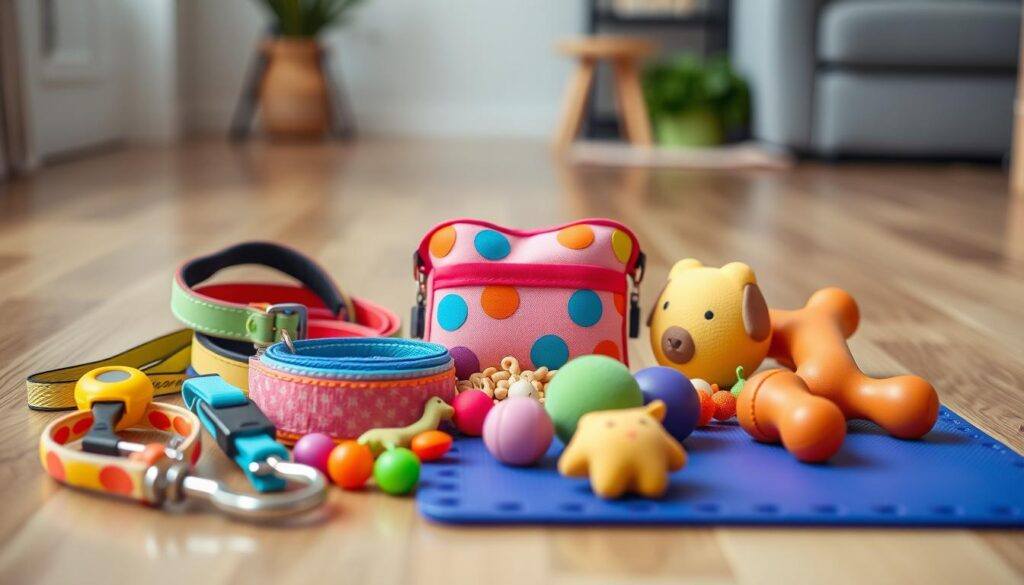
Creating a Positive Training Environment
Puppies thrive in a positive training environment devoid of distractions and filled with encouragement. Choose a quiet, familiar spot in your home where your puppy feels comfortable and can focus on you. Ensure the area is free from hazards or tempting objects that could disrupt training. Keep sessions short and upbeat, praising and rewarding your puppy for their successes. This approach fosters a lifelong love for learning and strengthens your bond with your puppy.
The Power of Positive Reinforcement!
Positive reinforcement is a game-changer in puppy training. It rewards good behavior, encouraging your puppy to repeat desired actions. This approach builds a strong bond and trust that lasts a lifetime.
A whopping 78% of dogs respond positively to positive reinforcement techniques. This is why many pet parents are adopting this method. It’s more effective and humane than punishment-based methods, making training fun for both you and your pup. Positive reinforcement involves rewarding your puppy for good behavior. This could be giving them a tasty treat for sitting on command or praising them when they come when called. Consistent rewards help your puppy understand what you expect, making training enjoyable for everyone.
Positive reinforcement does more than teach obedience. It boosts your puppy’s confidence and strengthens your bond. In fact, 82% of dog owners believe quality time during training sessions strengthens their bond. So, you’ll not only have a well-behaved pup but also a deeper connection with them.
Want to incorporate positive reinforcement into your training routine? Here are some tips:
- Choose high-value treats that your puppy loves and reserve them for training.
- Keep training sessions short and sweet, focusing on one command at a time.
- Reward your puppy immediately after they perform the desired behavior, so they make the connection between the action and the reward.
- Use a happy, upbeat tone of voice when praising your puppy, and don’t be afraid to get excited when they do something right!
Remember, patience and consistency are key in positive reinforcement training. With time and dedication, you’ll be amazed at what your furry friend can learn and how strong your bond can grow.
Command #1: Sit!
Teaching your puppy the sit command is a crucial part of their training. It helps with impulse control and makes them easier to manage. Plus, it lays a solid foundation for more advanced training later on.
Why is teaching your puppy to sit so important?
It helps prevent them from jumping up on people or engaging in unwanted behaviors. It’s a simple yet effective way to keep your puppy calm and focused, whether at home or out and about.
Step-by-Step Guide to Teaching “Sit”
Ready to get started? Follow these easy steps to teach your puppy the sit command:
- Hold a tasty treat close to your puppy’s nose to get their attention.
- Slowly move the treat above their head, causing them to look up and naturally sit down.
- As soon as their bottom touches the ground, say “sit” and give them the treat.
- Repeat this process several times a day, gradually phasing out the treat and using just the verbal cue.
Remember to keep training sessions short and fun. Always reward your puppy with praise and treats when they get it right. With patience and consistency, your puppy will soon be a pro at the sit command!
Command #2: Come!
Teaching your puppy to come when called is crucial. A reliable recall ensures their safety and gives you peace of mind. It means they will return to you, even in distracting situations.

The Importance of a Reliable Recall
Imagine your puppy slipping out the front door and running towards a busy street. In this scenario, a solid recall could save their life. Teaching your puppy to come when called is not only convenient but also crucial for their safety and well-being.
A reliable recall allows you to:
- Keep your puppy away from dangerous situations
- Call them back when they’re getting into mischief
- Enjoy off-leash adventures with confidence
Mastering the “Come” Command
To teach your puppy to come, start in a low-distraction environment, such as your living room or backyard. Follow these steps:
- Say your puppy’s name followed by “come” in a cheerful voice.
- When they start moving towards you, praise them enthusiastically.
- As soon as they reach you, reward them with a high-value treat and affection.
- Gradually increase the distance and distractions as your puppy masters the command.
Pro tip: Always make coming to you a positive experience for your puppy. Never call them to you for punishment or to end playtime, as this can make them reluctant to respond to the command in the future.
With patience and consistent training, you can develop a reliable recall for your puppy. This ensures their safety and strengthens your bond.
Command #3: Stay!
Teaching your puppy the “stay” command is a crucial part of their training. It helps them learn to stay in one place until you say it’s okay to move. This skill is useful in many situations, like when you answer the door or during meals.
When to Use the “Stay” Command
The “stay” command is handy in several situations, including:
- Keeping your puppy in place while you answer the door
- Preventing your pup from begging at the dinner table
- Ensuring your dog stays put while you step away briefly
By teaching your puppy to stay, you gain better control over their behavior. This keeps them safe in distracting or dangerous situations.

Teaching Your Puppy to Stay Put
To start teaching your puppy the stay command, follow these steps:
- Begin with your puppy in a sit or down position.
- Say “stay” in a clear, firm voice.
- Take a step back, keeping your eyes on your puppy.
- If your puppy stays, reward them with a treat and praise.
- Gradually increase the distance and duration as your puppy improves.
Keep training sessions short, about 5-10 minutes. Always use positive reinforcement when your puppy successfully stays. With patience and consistency, your puppy will learn the stay command quickly!
Command #4: Down!
Teaching your puppy to lie down is a crucial skill for their life. The “down” command helps keep them calm in many situations. This includes when you have guests or when dining out.
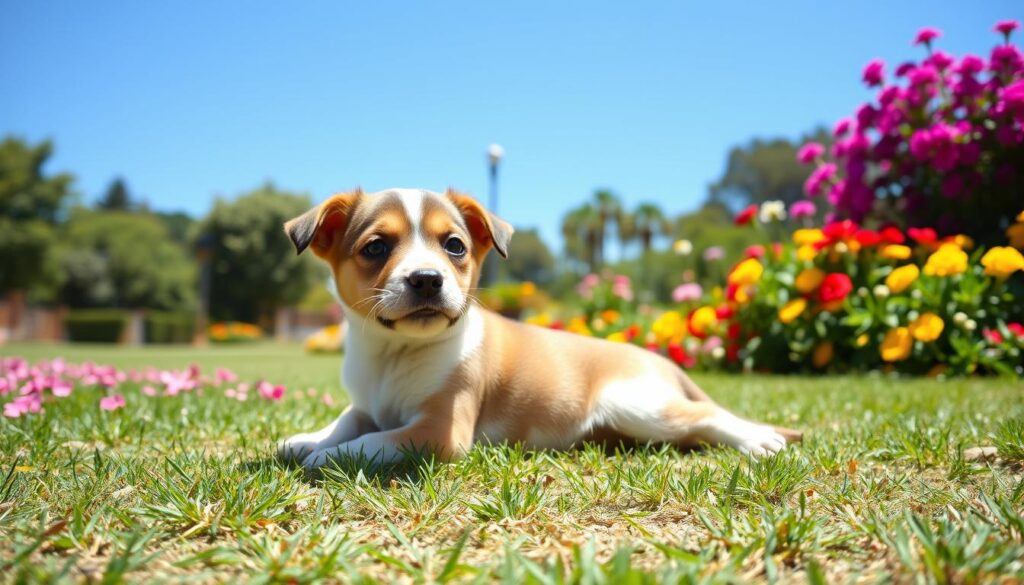
To start, place your puppy in a sit position. Hold a treat near their nose and slowly move it down. As they follow the treat, they’ll naturally lie down. Say “down” immediately after they lie down, rewarding them with the treat and praise.
Continue this exercise, gradually removing the treat. Focus more on the verbal cue. With regular practice, your puppy will learn to associate “down” with lying down. Keep training sessions brief, around 5 to 10 minutes. Use treats, praise, or play to keep them interested. Positive reinforcement is key for puppies, leading to quicker learning.
Practice the “down” command in different places and with distractions. This ensures your puppy can perform it reliably. With patience and consistent positive reinforcement, your puppy will master the “down” command.
Command #5: Leave It!
Teaching your puppy the “leave it” command is vital for their safety and self-control. This command instructs your puppy to ignore harmful or inappropriate objects. It helps them develop better decision-making and impulse control.
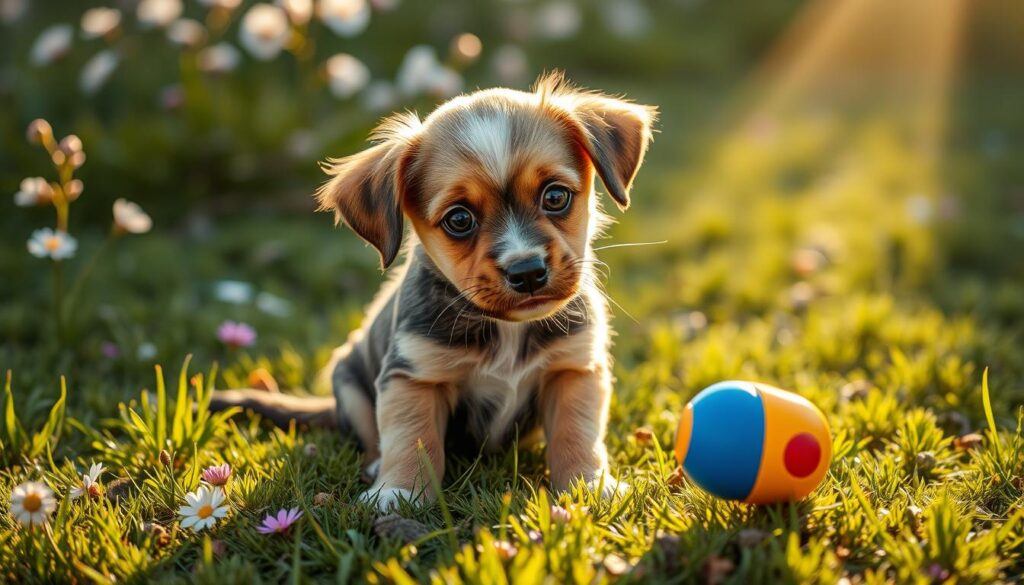
Keeping Your Puppy Safe with “Leave It”
The “leave it” command is key to preventing your puppy from getting into trouble. It keeps them away from dangerous objects, unwanted food, or other animals. A study found that 93% of dog owners see proper training, including “leave it,” as essential for their pet’s safety.
Training Your Puppy to Ignore Distractions
To teach “leave it,” place a treat on the floor and cover it with your hand. Say “leave it” when your puppy tries to get it. Reward them with another treat and praise when they ignore it. Gradually increase the temptation to improve their focus.
Training should be short, fun, and rewarding. Incorporating “leave it” into your daily routine lays a strong foundation for your puppy’s behavior. This ensures a lifetime of good habits.
Command #6: Drop It!
Teaching your puppy the “drop it” command is crucial for their safety and your peace of mind. This command tells your puppy to let go of an object when asked, preventing them from guarding resources or eating harmful things. A recent survey found that 78% of puppy owners believe training their furry friend to drop objects is essential.
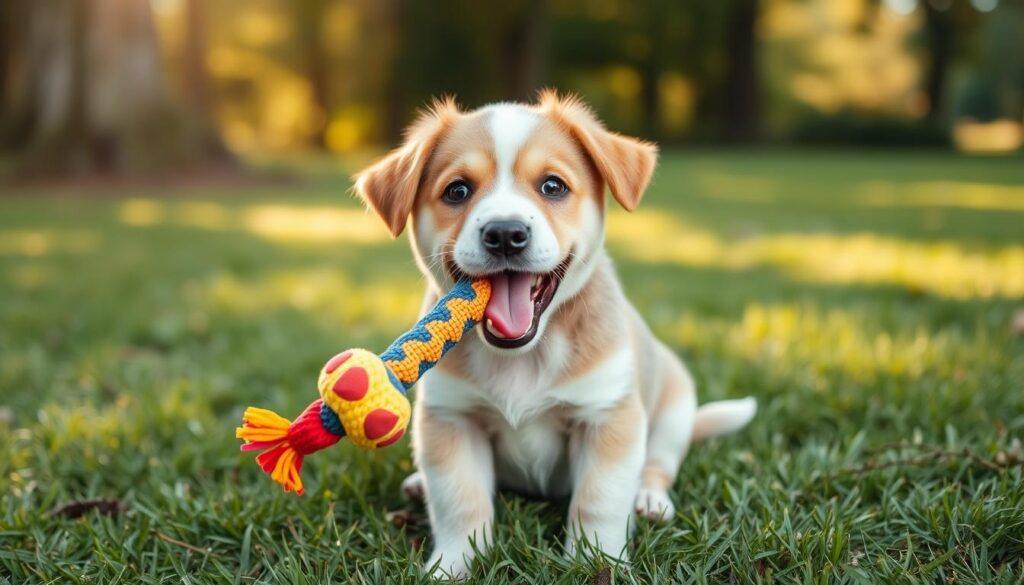
To teach your puppy to drop it, begin by playing with them using a toy. Hold a treat near their nose and say “drop it” when they have the toy. When they drop the toy for the treat, reward them and praise them. Do this several times until they learn to associate the command with letting go.
Statistics indicate that 85% of successful puppy training cases involve teaching the “drop it” command. Consistent practice of this command helps your puppy understand it as a positive action leading to rewards. As they get better, you can use more valuable objects and practice in various settings.
Remember, patience and consistency are vital when teaching your puppy to drop it. With regular practice and positive reinforcement, your puppy will learn to release objects on command. This makes playtime and daily life safer and more enjoyable for both of you.
Command #7: Heel!
Teaching your puppy to heel is essential for their training. It ensures they walk calmly beside you on a loose leash. This skill not only enhances your walks but also keeps them safe in different scenarios.
The Benefits of Loose-Leash Walking
Loose-leash walking has many benefits for puppies. It prevents them from pulling on the leash, avoiding neck and throat injuries. A well-behaved puppy makes walks enjoyable, allowing you to explore new places together.
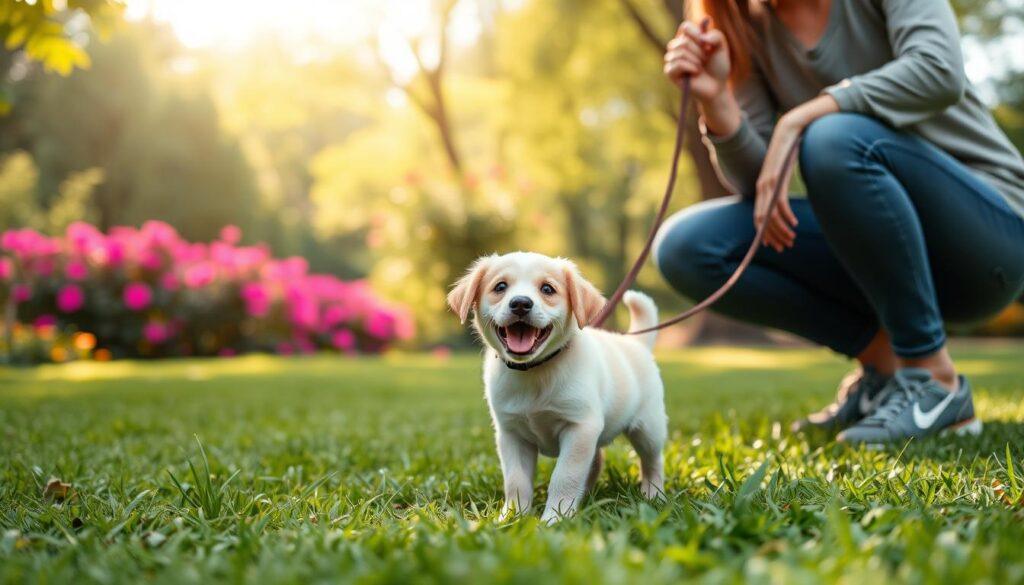
Teaching Your Puppy to Walk Calmly Beside You
To teach your puppy to heel, start by placing them on your left side. Hold a treat near your left hip and take a step forward. As they follow the treat, say “heel” in a clear, positive tone. Reward them with the treat and praise when they stay in position.
Gradually increase the steps before rewarding your puppy. Practice in various locations to reinforce the command. Remember, keep training sessions short and engaging due to puppies’ short attention spans. Patience and consistency are crucial in teaching your puppy to heel. With time and practice, walks will become a joyful experience for both of you.
Command #8: Off!
Teaching your puppy the “off” command is vital for setting boundaries and stopping unwanted actions. When your puppy jumps on you, furniture, or other items, it’s crucial to teach them to get off upon request. This command ensures your dog remains well-behaved and respectful at home.
To teach your puppy to get off, follow these simple steps:
- When your puppy jumps on you or an object, calmly say “off” in a firm tone.
- Gently guide your puppy back to the floor, encouraging all four paws to touch the ground.
- Once your puppy is off, immediately reward them with a treat and plenty of praise.
- Repeat this process consistently, using the “off” command whenever necessary.
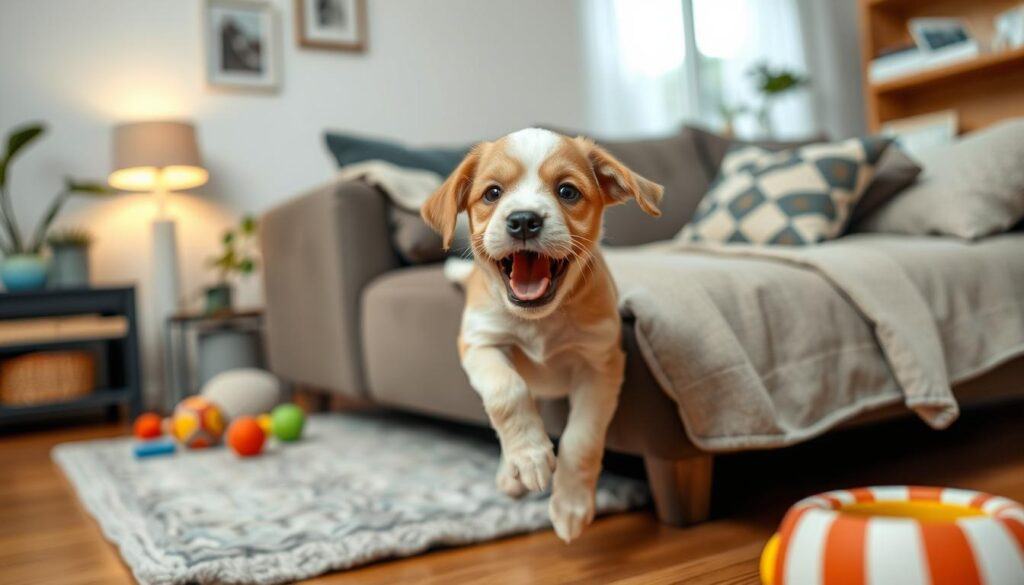
Consistency is crucial in training your puppy. By teaching the off command early, you’ll help them understand that jumping on people or objects is not acceptable. With patience and positive reinforcement, your puppy will learn to respect boundaries and respond to the “off” command reliably.
Fun Fact: Did you know that puppies often jump on people as a way to greet them? While it may be cute when they’re small, it’s important to teach them that this behavior is not appropriate for a well-mannered dog.
Command #9: Watch Me!
Teaching your puppy the “watch me” command is essential for a strong bond and focus during training. It aims to capture your puppy’s attention and maintain eye contact, even with distractions. This command is a stepping stone for more complex training and keeps your puppy engaged.
Getting Your Puppy’s Attention
To teach your puppy to watch you, hold a treat near your eyes. Say “watch me” clearly and wait for eye contact. Reward them with the treat and praise when they look at you. Repeat this, increasing the eye contact time before rewarding.
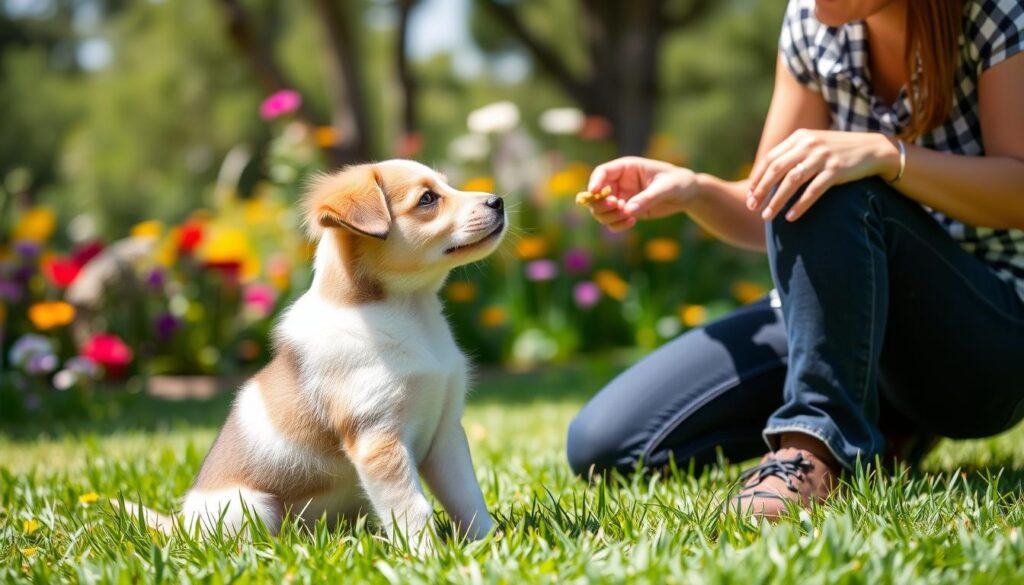
As your puppy masters the “watch me” command, introduce distractions. This could be another person, toys, or different locations. The aim is to keep your puppy focused on you, despite temptations.
Building Focus and Engagement
Integrate the “watch me” command into your daily routine to enhance focus and engagement. Use it before other commands like “sit” or “stay” to ensure attention. It’s also useful during walks or playtime to refocus your puppy’s attention.
Consistency is crucial when teaching your puppy to watch you. Practice in various settings and reward attention and focus. With patience and repetition, your puppy will eagerly follow your guidance.
Command #10: Stand!
Teaching your puppy the “stand” command is a crucial part of their training. It’s useful in many situations, like grooming or vet visits. This command helps your puppy learn to stand still, making these moments less stressful for both of you.
When to Use the “Stand” Command
The “stand” command is handy in many scenarios. It’s useful when brushing, trimming nails, or at the vet. It also aids in dog sports, like conformation shows, where dogs must stand for judging.
Training Your Puppy to Stand on Command
To teach your puppy to stand on command, follow these steps:
- Start with your puppy in a sit or down position.
- Hold a treat near their nose to grab their attention.
- Slowly move the treat forward, guiding your puppy to follow it with their nose.
- When your puppy stands up to reach the treat, say “stand” clearly and positively.
- Give your puppy the treat and lots of praise when they stand up.
- Repeat this several times, increasing the stand time before rewarding.
Keep training sessions short and fun for your puppy. With patience and consistency, your puppy will learn to stand on command. This adds a valuable skill to their training.
Commands to Teach a Puppy for a Well-Behaved Dog!
As a new puppy owner, you might wonder about the essential puppy training commands to teach your furry friend. Teaching your puppy these 10 puppy commands – sit, come, stay, down, leave it, drop it, heel, off, watch me, and stand – is crucial. It lays the foundation for a well-behaved adult dog.
Consistency, patience, and positive reinforcement are key to successful puppy training. Rewarding good behavior is one of the most effective ways to encourage your puppy. Commands like “stay,” “leave it,” or “off” can significantly impact your puppy’s training and behavior.
Regular practice and reinforcement are necessary for your puppy to understand and respect set boundaries. Well-exercised puppies are more likely to respect boundaries. So, make sure to provide your puppy with plenty of physical activity and mental stimulation. Celebrate small wins and address setbacks with understanding and care throughout the training process.
By teaching your puppy these essential puppy training commands, you’ll be setting them up for success. You’ll create a harmonious home environment built on trust and safety. So, grab some treats, put on your patient hat, and start training your puppy today!
Benefits of Using a Dog Training Clicker and Ultrasonic Whistle!
Training your puppy effectively requires the right tools. The dog training clicker and ultrasonic whistle are essential. They enhance communication, speeding up the learning process for both you and your puppy.
How Clickers Enhance Training
A dog training clicker is a small device that makes a distinct sound when pressed. It marks the exact moment your puppy performs a desired action, like sitting. Consistently linking the click with a treat teaches your puppy to associate the sound with a reward. Clicker training relies on positive reinforcement, a proven method for teaching dogs. It provides precise, timely feedback, helping your puppy learn faster and with less confusion.
The Advantages of Ultrasonic Whistles
An ultrasonic whistle is a powerful tool for communicating with your puppy, even in noisy places. It emits a high-pitched sound dogs can hear but humans can’t. This makes it perfect for grabbing your puppy’s attention from afar.
Ultrasonic whistles are great for recall training. They help you call your puppy back when they’re off-leash or in a big area. Consistent use and rewards build a strong recall, ensuring your puppy’s safety.
Using a dog training clicker and ultrasonic whistle in your puppy’s training can speed up progress and reduce frustration. Consistent use with positive reinforcement techniques will help you raise a happy, well-behaved dog.
Recommended Puppy Training Kit: BARKIE Dog Training Kit!

Training your new furry friend requires the right tools. The BARKIE Dog Training Kit is designed to make training easier and more enjoyable. It helps you effectively train your pup, enhancing the bond between you and your dog.
The BARKIE Dog Training Kit is an affordable, all-in-one solution for puppy owners. It comes with tools and accessories to teach your pup essential commands and behaviors. This kit ensures your pup becomes a well-behaved family member.
What’s Included in the BARKIE Dog Training Kit
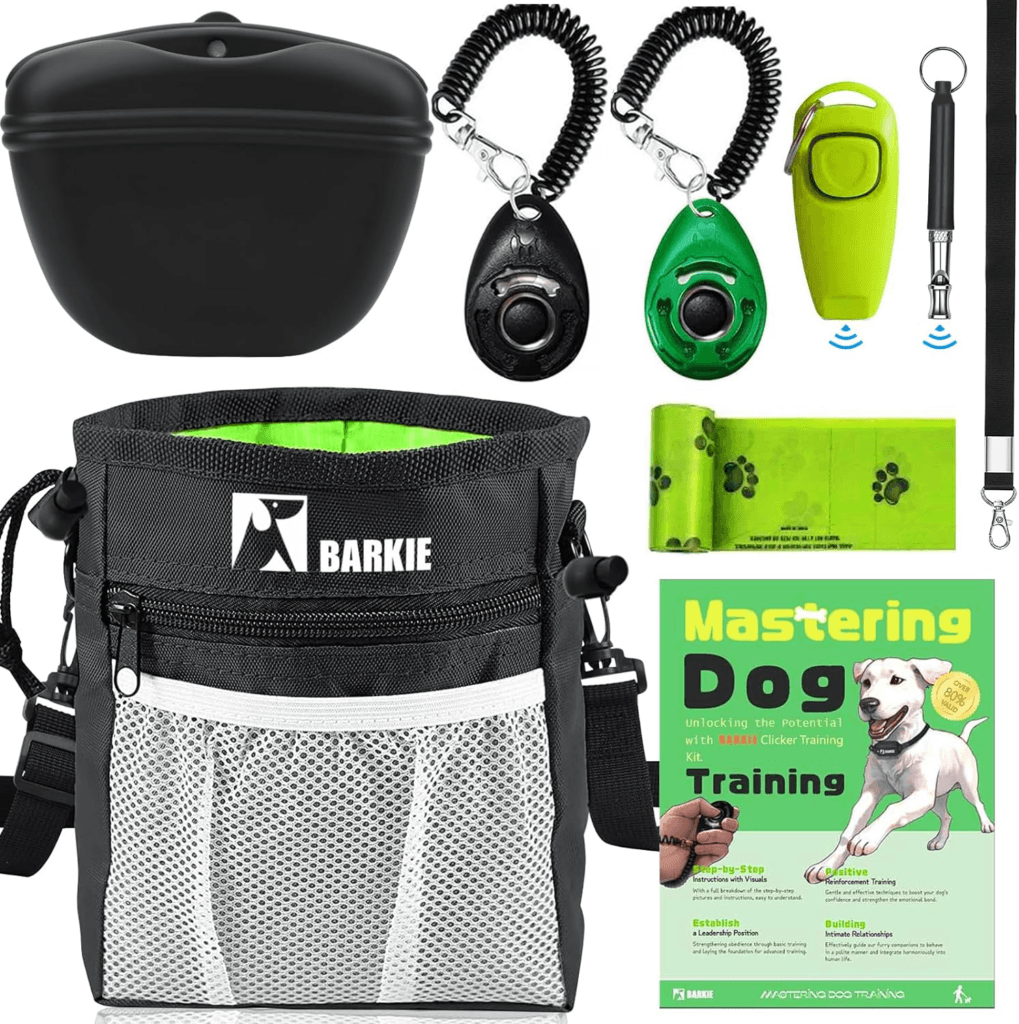
The BARKIE Dog Training Kit includes various tools for effective puppy training:
- Treat pouch for convenient reward storage during training sessions
- Clickers to mark and reinforce desired behaviors
- Ultrasonic whistle for long-distance recall training
- Clicker training guide to help you get started
- And more!
How the BARKIE Dog Training Kit Can Help You Train Your Puppy
The BARKIE Dog Training Kit offers a comprehensive set of tools in one package. It makes staying consistent with your puppy’s training easier. The included clicker training guide provides valuable tips and techniques for effective training sessions.
With the BARKIE Dog Training Kit, you’ll have everything needed to teach your puppy essential commands. This affordable and comprehensive kit sets your puppy up for a lifetime of good behavior. It also strengthens the bond between you and your furry best friend.

Conclusion!
Training your puppy with these 10 essential commands is a crucial step in raising a well-behaved dog. Consistently using positive reinforcement techniques and dedicating time to puppy training fosters a strong bond. Remember, patience is key as you guide your puppy through each command, from basic obedience like “sit” and “stay” to more advanced skills such as “heel” and “watch me”.
Investing in a high-quality puppy training kit, such as the BARKIE Dog Training Kit, can make the process more effective and enjoyable for both you and your pup. With tools like a clicker and ultrasonic whistle, you’ll be able to communicate clearly and reinforce good behavior, leading to faster progress.
By laying a solid foundation of obedience and good manners, you’ll set your puppy up for a lifetime of success as a well-behaved dog. This not only makes your life easier but also ensures your dog is a joy to be around for family, friends, and the community. So, embrace the journey of puppy training, and watch as your furry friend blossoms into a confident, happy, and obedient companion.
Frequently Asked Questions!
Q: What are the benefits of teaching my puppy basic commands?
A: Teaching your puppy basic commands is essential. It fosters good behavior, strengthens your bond, and builds trust. A well-trained dog is safer and easier to live with. They are more likely to respond correctly in dangerous situations, like stopping near traffic. Basic commands also provide mental stimulation for your puppy. This reduces boredom and destructive behavior. A well-trained puppy adapts better to new environments, social interactions, and routines. This makes life more enjoyable for both you and your furry friend.
Q: When should I start training my puppy?
A: Begin training your puppy as early as possible, ideally around 8 weeks old. At this age, puppies are highly receptive to learning. It’s the perfect time to introduce basic commands like “sit,” “stay,” and “come.” Early training helps them develop good habits and strengthens the bond between you and your puppy. Consistent, positive reinforcement during these early weeks is key. It lays the foundation for a well-behaved and happy dog as they grow. This early start is essential for their development and your relationship with them.
Q: What tools do I need for puppy training?
A: Essential tools for puppy training include treats, toys, clickers, and a comfortable leash and collar. The right tools make training more effective and enjoyable for both you and your puppy.
Q: What is positive reinforcement, and why is it important in puppy training?
A: Positive reinforcement is a training method that rewards good behavior to encourage your puppy to repeat desired actions. This can include treats, praise, or playtime immediately following the behavior you want to reinforce. It’s more effective and humane than punishment-based training, as it focuses on teaching your puppy what to do. Positive reinforcement not only helps your puppy learn faster but also builds trust, strengthens your bond, and creates a happy and confident dog eager to learn and please. This approach is essential for a positive and effective training experience.
Q: What are the most important commands to teach my puppy?
A: The 10 essential commands are: sit, come, stay, down, leave it, drop it, heel, off, watch me, and stand. These commands form the foundation for a well-behaved adult dog. They help in various situations.
Q: How long does it take to train a puppy?
A: The time it takes to train a puppy varies significantly, influenced by several factors. These include the puppy’s age, breed, personality, and the training methods employed. Consistency and frequency in training are also key. Most puppies can grasp basic commands like “sit” and “stay” within a few weeks to a few months. This is achievable with regular practice and positive reinforcement. Yet, more complex behaviors or advanced training, such as mastering leash manners or off-leash recall, may require more time. Patience is essential, as is making training sessions enjoyable and rewarding. This approach fosters faster learning and strengthens the bond between the puppy and its owner.
Q: What are the benefits of using a clicker and ultrasonic whistle in puppy training?
A: Clickers offer a clear and consistent signal for desired behaviors, making it easier for your puppy to link their actions with rewards. This approach makes training more efficient and enjoyable for both of you. They are perfect for teaching basic commands such as “sit,” “stay,” and “down. Ultrasonic whistles, on the other hand, are designed to capture your puppy’s attention, even in noisy or distracting environments. This makes them ideal for recall training and commands during outdoor activities. By combining these tools, you can enhance communication, reinforce positive behaviors, and speed up your puppy’s learning process.
Q: Can you recommend a good puppy training kit?
A: The BARKIE Dog Training Kit is a complete, budget-friendly package for new puppy owners. It comes with a treat pouch for effortless rewards, training clickers for positive feedback, an ultrasonic whistle for recall, and a detailed guide on clicker training. The kit also includes extra tools to enhance the effectiveness and fun of training sessions. This all-in-one solution makes it easy to start a consistent and successful training program. Dog owners highly praise it for its quality and simplicity.

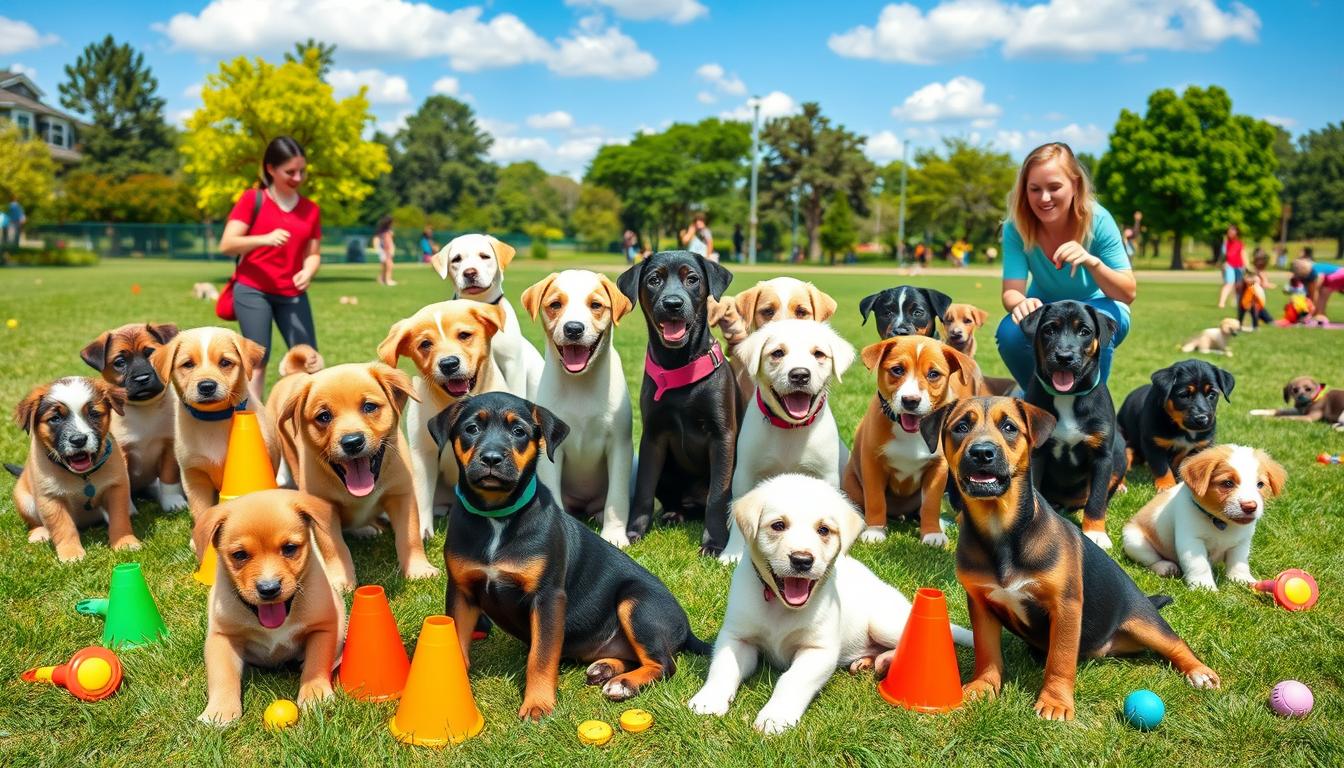
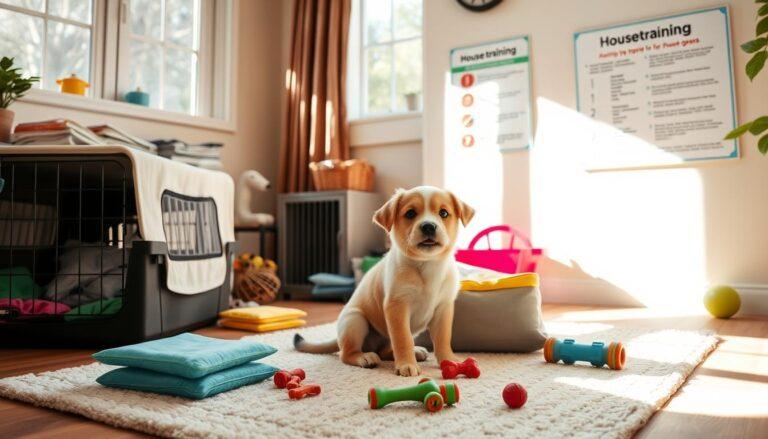
I love how your article emphasizes starting early and using positive reinforcement. When I got my first dog, I really had to buckle down, be patient, and ensure that I didn’t rely solely on negative corrections. What are your guys favorite training tips or commands to teach, and have you found certain tools, like clickers or treats, really effective in motivating your pups?